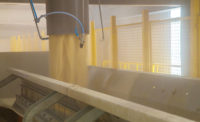2020 Top Standards: National Fire Protection Association (NFPA)
NFPA 652 standard on fundamentals of combustible dust

History:
Originally published in 2015.
Updated in 2019.
Definition:
As defined by OSHA, combustible dust is “a solid material composed of distinct particles or pieces, regardless of size, shape or chemical composition, which can present a fire or deflagration hazard when suspended in air or some other oxidizing medium over a range of concentrations.”
In general, some 70% of dusts are explosible and, given an adequate ignition source and appropriate dust/air concentration, can cause a dust explosion.
Non-explosible materials such as sand or silica could become explosible if mixed with other explosible material (such as organic and/or metal dust) in adequate quantities. It’s important to screen representative samples to determine and document if a mixture of material is explosible or not.
Scope:
NFPA 652 serves the chemical, wood processing, metals, and agricultural industries.
Combustible dust-related fires and explosions are a global problem, and in the United States alone, 50 dust-related incidents occurred between 2008 and 2012. This updated edition of NFPA 652 is essential to manage the dust-related fire, flash fire, and explosion hazards in industries that use dust collection and handling equipment, or that have processes that may generate combustible dust.
NFPA 652 directs users to NFPA's appropriate industry- or commodity-specific standards, which include:
- NFPA 61, Prevention of Fires and Dust Explosions in Agricultural and Food Processing Facilities
- NFPA 484, Combustible Metals
- NFPA 654, Prevention of Fire and Dust Explosions from the Manufacturing, Processing, and Handling of Combustible Particulate Solids
- NFPA 664, Prevention of Fires and Explosions in Wood Processing and Woodworking Facilities
NFPA 652 gives installers, contractors, engineers, facility managers, code enforcers, inspectors, and environmental health and safety (EHS) personnel a single go-to source for the information necessary to help handle combustible dust safely in any industry, anywhere around the globe.
Major changes in the 2019 update:
- Deadlines were changed for the completion of dust hazard analysis (DHA) for existing processes and facility compartments. The deadline is now September 7, 2020. NFPA 652 also requires that the DHA be reviewed and updated every 5 years.
- Revised general requirements for managing combustible dust fire and explosion hazards.
- New references to the latest editions of NFPA’s appropriate industry- or commodity-specific standards.
Contents:
- Definitions
- General Requirements
- Hazard Identification
- Performance-Based Design Option
- Process Hazards Analysis
- Hazard Management: Mitigation and Prevention
Dust hazard analysis:
A Dust Hazard Analysis (DHA) is a systematic review of the processes and areas of your facility where combustible particulate solids are present. The analysis will help identify the fire, flash-fire, and explosion hazards that exist in your facility. The DHA will categorize locations into one of three general categories: Not a hazard, Might be a hazard, or Deflagration (or Fire, or Flash-Fire) hazard. Locations that fall into the second category will often require additional information or analysis to determine if a hazard exists or not. For each hazard identified, safe operating ranges must be defined as well as any existing hazard management measures and a list of additional hazard management options for consideration.
The goal of your DHA is to identify all the hazards in your facility–especially the ones you did not even know existed. For example, the well-known Port Wentworth, Georgia Imperial Sugar Refinery explosion in 2008 was the result of unknown hazards. A conveyor enclosure created the necessary confinement for dust that was leaking and dispersed from silo outlets, and an overheated bearing inside the enclosure is believed to have been the ignition source. This initial explosion ignited several secondary explosions that had plenty of fuel due to fugitive dust accumulation and poor housekeeping. A DHA likely would have identified these hazards so they could have been addressed.
When is a DHA required?
Always. The requirement to conduct a DHA applies retroactively to existing facilities and processes, and NFPA 652 also requires a DHA for all new processes and facilities.
Who performs a DHA?
NFPA 652, Section 7.2.2 states:
The DHA shall be performed or led by a qualified person.
The Explanatory Material in Annex A (not enforceable, but provided for clarification) elaborates:
The qualified person who is leading or performing the DHA should be familiar with conducting a DHA. The qualified person should also be familiar with the hazards of combustible dusts. Typically, a team performs a DHA. For some processes this team might be as little as two persons, or for larger and more complex processes, the team might require many more than two persons. This team is made of a variety of persons whose background and expertise can include the following:
- Familiarity with the process
- Operations and maintenance
- Process equipment
- Safety systems
- History of operation
- The properties of the material
- Emergency procedures
The individuals involved in the DHA could include facility operators, engineers, owners, equipment manufacturers, or consultants.
While NFPA 652 does not explicitly define who is a “qualified person,” it does provide good guidelines for facility owners to consider when choosing a consultant/facilitator or assembling a DHA team. It is possible that you have internal staff who are qualified and capable of conducting a DHA for your facility, but do not discount the value of an outside perspective. A fresh set of eyes may identify hazards your staff could overlook, and someone who has performed DHAs in other industries can also provide valuable insights that apply to your facility and processes.
Source: https://www.hallam-ics.com/blog/what-is-a-dust-hazard-analysis-dha
Combustible dust explosion prevention:
- Implement a hazardous dust inspection, testing, housekeeping and control program.
- Use proper dust collection systems.
- Regularly inspect for dust residues in open and hidden areas.
- If ignition sources are present, use cleaning methods that do not generate dust clouds.
How to clean combustible dust:
OSHA recommended housekeeping procedures include, but are not limited to:
- Clean dust residues at regular intervals;
- Use cleaning methods that do not generate dust clouds, if ignition sources are present (such as blow-down methods);
- Only use vacuum cleaners approved for dust collection.
NFPA 652 can be purchased at:
Sponsor:
www.camfilapc.com, 800-479-6801
|
2020 Top Standards Article Index ANSI/ISEA 121- Dropped object prevention solutions NFPA 652 standard on fundamentals of combustible dust OSHA most frequently violated standardsFall protection- General Requirements (1926.501) Hazard Communication (1910.1200) The Control of Hazardous Energy (Lockout/Tagout) 1910.147 Respiratory Protection (1910.134) Powered Industrial Trucks (1910.178) |
Looking for a reprint of this article?
From high-res PDFs to custom plaques, order your copy today!







